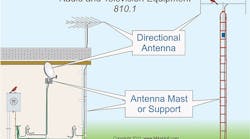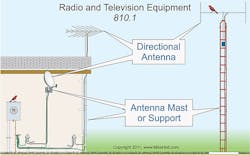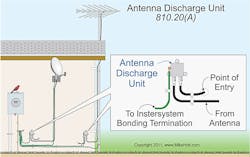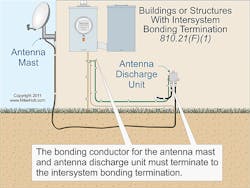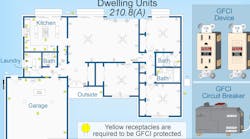Article 810 contains the installation requirements for the wiring of television and radio receiving equipment (Fig. 1). The types of equipment covered includes:
• Satellite antennas. Large satellite dish antennas (often about 6 ft in diameter) usually have a motor that moves the dish to focus on different satellites. The smaller satellite dish antennas (18 in. in diameter) are usually aimed at a single satellite.
• Roof-mounted antennas for AM/FM/XM radio reception.
• Amateur radio transmitting and receiving equipment, including HAM radio equipment.
Wiring from the power supply to this type of equipment must be installed per Chapters 1 through 4 [810.3]. But let’s not become confused here. Wiring for audio equipment must comply with Art. 640 requirements. Coaxial cables that connect antennas to equipment must be installed per Art. 820, and the grounding requirements for antenna cables are in 810.20(C) and 810.21, not Art. 820.
Antenna systems
A community TV antenna is used for multiple-occupancy facilities, such as apartments, condominiums, motels, and hotels. The antenna for community television systems must be installed per the rules of Art. 810, but coaxial cable beyond the point of entrance must be installed per Art. 820.
Make sure you securely support outdoor antennas and lead-in conductors. Securely attach the lead-in conductors to the antenna [810.12]. Note that you can’t attach outdoor antennas to the electric service mast [230.28].
Ground outdoor masts (and metal structures that support antennas) per 810.21 [810.15].
Keep outdoor antennas and lead-in conductors at least 2 ft from exposed electric power conductors. Lead-in conductors attached to buildings must be installed so they can’t swing closer than 2 ft to the conductors of circuits of 250V or less — or closer than 10 ft to the conductors of circuits of more than 250V. Keep lead-in conductors at least 6 ft from the lightning protection system.
Underground antenna lead-in conductors must maintain a separation at least 12 in. from electric power conductors. This separation isn’t required where the underground antenna lead-in conductors or the electric power conductors are installed in a raceway or cable armor.
Don’t use a lightning protection system grounding electrode as the building/structure grounding electrode [250.60].
Metal raceways, enclosures, frames, and metal parts of electric equipment must be bonded to the lightning protection system, but this bonding is optional where there’s adequate separation. Separation from lightning protection conductors is typically 6 ft through air or 3 ft through dense materials, such as concrete, brick, or wood. The lightning system itself, however, must always be bonded to the building/structure grounding electrode system [250.106].
Indoor antenna and lead-in conductors must be at least 2 in. from electrical power conductors. This requirement is waived, however, if you run the antenna lead-in conductors or electrical power conductors in a raceway or cable armor. Indoor antenna lead-in conductors can be in the same enclosure with electric power conductors where separated by an effective, permanently installed barrier.
Each lead-in conductor from an outdoor antenna must have a listed antenna discharge unit [810.20] (Fig. 2). Install the antenna discharge unit nearest the point of entrance but not near combustible material.
Bonding conductor or grounding electrode conductors
A welcome change to Art. 810 is it no longer uses the confusing term “grounding conductor.” Instead, it now says either “bonding conductor” or “grounding electrode conductor” (GEC) where applicable.
Grounding the lead-in antenna cables and the mast helps prevent voltage surges caused by static discharge (or nearby lightning strikes) from reaching the center conductor of the lead-in coaxial cable. Because the satellite dish sits outdoors, wind creates a static charge on the antenna and on the cable attached to it.
This charge can build up until it jumps across an air space, often passing through the electronics inside the low-noise block down converter feedhorn (LNBF) or receiver. Connecting the coaxial cable and dish to the building grounding electrode system helps to dissipate this static charge.
Nothing can prevent damage from a direct lightning strike, but grounding with proper surge protection can help reduce induced-surge damage to the satellite dish and other equipment.
The antenna mast [810.15] and antenna discharge unit [810.20(C)] must be grounded as follows [810.21]:
(A) Material. The conductor to the electrode [810.21(F)] must be copper or other corrosion-resistant conductive material, stranded or solid.
(B) Insulation. Insulated, covered, or bare.
(C) Supports. The bonding conductor or GEC must be securely fastened in place.
(D) Mechanical protection. The bonding conductor or GEC must be mechanically protected where subject to physical damage. Where installed in a metal raceway, each end of the raceway must be bonded to the bonding conductor or GEC.
(E) Run in straight line. The bonding conductor or GEC must be run in as straight a line as practicable.
(F) Electrode. The bonding conductor or GEC must meet specific termination requirements (see Termination Requirements for GEC and Bonding Conductor).
(G) Inside or outside building. You can install the bonding conductor or GEC inside or outside the building.
(H) Size. The bonding conductor or GEC must not be smaller than 10 AWG copper or 17 AWG copper-clad steel or bronze.
(J) Bonding of electrodes. If a ground rod is installed to serve as the grounding electrode for the radio and television equipment, connect it to the building’s power grounding electrode system with a minimum 6 AWG conductor.
(K) Electrode connection. Termination of the bonding conductor or GEC must be by exothermic welding, listed lugs, listed pressure connectors, or listed clamps. Grounding fittings that are concrete-encased or buried in the earth must be listed for direct burial [250.70].
Amateur and CB radio systems
Antenna systems for amateur and citizen band transmitting and receiving stations must comply with these additional requirements [810.51]:
• Lead-in conductors must be securely attached to the antenna [810.12].
• Outdoor antennas and lead-in conductors must be kept at least 2 ft from exposed electric power conductors [810.13].
• Outdoor masts and metal structures that support antennas must be grounded per 810.21 [810.15].
• Antenna lead-in conductors must be firmly mounted at least 3 in. from the surface of the building [810.54].
• Each lead-in conductor from an outdoor antenna must have a listed antenna discharge unit or other suitable means to drain static charges from the antenna system [810.57]. This requirement is waived if the conductor is protected by a continuous metallic shield that’s grounded per 810.58 or if the antenna is grounded per 810.58.
• The bonding conductor or GEC must be the same size as the lead-in conductors, but not smaller than 10 AWG copper, bronze, or copper-clad steel.
• The bonding conductor or GEC for transmitting stations must not be smaller than 14 AWG copper or its equivalent [810.58].
Key compliance points
To ensure your work complies with the requirements set forth in Art. 810, keep these points in mind:
• Avoid contact with conductors of other systems.
• Don’t attach antennas or other equipment to the service-entrance power mast.
• If the mast isn’t grounded properly, voltage surges caused by nearby lightning strikes can destroy it.
• Keep the bonding conductor or GEC as straight as practicable, and protect it from physical damage.
• If the antenna mast isn’t bonded properly, you risk flashovers and possible electrocution.
• The purpose of bonding is to prevent a difference of potential between metallic objects (and other conductive items, such as swimming pools).
Finally, remember that clearances are critical. Article 810 provided detailed clearance requirements because you want that antenna to receive radio signals, not electrical power from nearby systems.
Holt is the owner of Mike Holt Enterprises, Inc. in Leesburg, Fla. He can be reached at www.mikeholt.com.
SIDEBAR: Termination Requirements for GEC and Bonding Conductor
An Intersystem Bonding Termination is a device that provides a means to connect bonding conductors for communications systems to the grounding electrode system while meeting the requirements of 250.94 [Art.100]. Bonding all systems to the intersystem bonding termination helps reduce induced potential (voltage) differences between the power and the radio and television systems during lightning events.
If the structure has an intersystem bonding termination, then the bonding conductor for the antenna mast and antenna discharge unit must terminate to the intersystem bonding termination (Figure). What if the structure doesn’t have this termination? In that case, the bonding conductor or GEC for the antenna mast and antenna discharge unit must terminate to the nearest accessible location on one of the following:
(1) Building/structure grounding electrode system [250.50].
(2) Interior metal water piping system, within 5 ft from its point of entrance [250.52(A)(1)].
(3) Accessible means external to the building, as covered in 250.94.
(4) Nonflexible metallic service raceway.
(5) Service equipment enclosure.
(6) GEC or the GEC metal enclosure.
